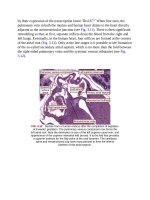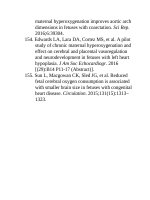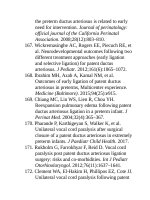Andersons pediatric cardiology 1802
Bạn đang xem bản rút gọn của tài liệu. Xem và tải ngay bản đầy đủ của tài liệu tại đây (109.66 KB, 3 trang )
andperioperativemanagement,andfinally,outcomesfortheseconditions.This
typeofapproachisimpossibleandinadequateforthemyriadofanatomic
conditionsthatrequireanapproachofstagedreconstruction.Inaddition,the
perioperativecareandshort-andlong-termoutcomesarequitesimilar
irrespectiveofthecardiacmalformationsnecessitatingthismanagementstrategy.
Thereforethefollowingchaptersapproachthemanagementofpatientswitha
functionallyuniventricularheartinasomewhatunorthodoxfashion(Fig.68.1),
emphasizingwhatisnecessaryforachildtoundergothe“Fontanpathway”with
thehighestlikelihoodofsurvival,alongwithbothagooddurationandqualityof
life.
FIG.68.1 TheFontanpathwayisatermusedcolloquiallytodenotethe
combinationofsurgicalprocedures(orange)andmedical
monitoring/management(blue)forchildrenandadultsbornwitha
functionallyuniventricularheart.Monitoringandmanagementduring
interstageIisbecomingmorestandardized,3–5whereasmedical
management,surveillanceforconsequencesoftheFontancirculation,and
guidelinesforcardiactransplantationremainhighlyvariableandcenter
specific.6,7
InChapter69,themultipleanatomicmalformationsthatdonotallowfora
biventricularrepairaredescribedandillustrated.ThisisfollowedinChapter70
byanin-depthdiscussionoftheanatomicandphysiologicprinciplesthat
maximizethesurvivalrateaswellastheultimatesuccessofthefinalplanned
surgicalprocedureinthisapproach,whichforthepurposesofthesechaptersis
simplycalledtheFontanprocedure,asitismostwidelyknown.Inthepast3
decades,recognitionoftheseimportantprincipleshasledtoabetter
understandingofthetimingandtechniquesrequiredfortheinitialand
subsequentsurgicalproceduresaswellasthephysiologicchangesduringand
afterstagedreconstruction.
Thephysiologicindicationsforthetype,timing,andnumberofsurgical
proceduresaredeterminedbytheuniqueanatomyofeachpatientwitha
functionallyuniventricularheart.Thesevarioussurgicalproceduresare
describedindetailinChapter71.Irrespectiveoftheanatomicsubstrateand
typesofsurgicalapproachesnecessary,theperioperativephysiologyand
managementfollowingeachoftheseproceduresissurprisinglysimilar;theseare
alsodiscussedinChapter71.Likewise,theprinciplesofinterstagemonitoring
(discussedinChapter72)aslong-termconsequences(discussedinChapter73)
arequitesimilarirrespectiveoftheunderlyinganatomy.
TheFontanprocedurehasbeenoneofthemostremarkableachievementsin
thefieldsofpediatriccardiologyandcardiacsurgery.Thepast5decadeshave
seenanexponentialincreaseinthenumberofpatientswhohavesurvivedinto
adolescenceandadulthoodwitha“Fontancirculation,”includinggratifying
examplesofsurvivalintothefourthandfifthdecadesoflife,successful
pregnancies,careersatisfaction,andanacceptablequalityoflife.However,
alongwiththissuccesshascomeanincreasedunderstandingofthelong-term
consequencesoftheFontancirculation,includingeffectsontheheartitself;the
impactonmultipleorgansystems,particularlythegut,liver,andbrain;the
psychosocialimpactofachronicmedicalcondition;theneedforadditional
interventional(seeChapter19)andsurgicalprocedures;aswellasthe
physiologicstateknownas“Fontanfailure,”thesurgicaloptionsforwhichare
extremelylimitedandthatmayultimatelyleadtocardiactransplantation(see
alsoChapter67).
Thefuturedirectionsandoutcomesforchildrenbornwithafunctionally
univentricularheartremainbothoptimisticandunknown.Despitethelongertermconsequencesnowbeingdescribedforchildrenundergoingstaged
reconstruction,therecanbeasenseofoptimism.Invirtuallyallcongenital
cardiacmalformations,increasedsurvivalratesandongoingresearchhaveledto
anincreasedunderstandingofthelong-termconsequencesofsurgical
interventions,followedbychangesinsurgical,medical,andinterventional
approaches,leadingtosubsequentimprovementsinsurvivalandqualityoflife
seenovertime.TheFontanpathwayisnoexception.Innovationsinmedical,
catheter,andtechnologicinterventionsaswellasthestandardizationoffollowupareunderway.8–13Webelievethatalthoughthelifelongoutcomesforour
currentandfuturepatientsareunknown,experiencetellsusthatthosewill
improveincrementallyovertime.
“Wecan'tsolveproblemsbyusingthesamekindofthinkingweused
whenwecreatedthem.”
–ALBERTEINSTEIN









